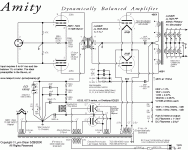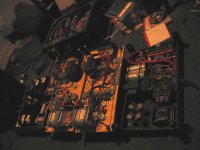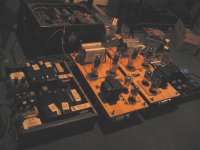I am late to this thread, but I do have a few comments to offer :^)
1) The 2A3 and 300B are very similar - gain, plate resistance, and transconductance are within 10-15% of each other. This is within the variation from sample to sample of the tubes. The circuit has voltage specs for both 2A3 and 300B; the limitation is the tube's heat dissipation limits. The operating points, normalized by the voltage, are very similar - the (shared) bias resistors are different in inverse proportion to the gain (mu) of the tube. So something like the 2A3-40 can be used at any voltage from 300v to 450v without any other changes. Note that the quiescent currents are on the high side - 85mA per tube for the 300B. If you use a "normal" P-P bias current, you will NOT be in the kind of deep Class A that is at the heart of this design.
2) The filament/cathodes are connected together, presumably to keep the bias resistor and its bypass cap out of the output current loop. But in spite of the requirement for "factory-matched" tube pairs, there will still be some difference in quiescent current, which will saturate the output transformer unless it has an adequate airgap. Note that an airgap capable of 20-60mA unbalanced current as specified is quite unusual, you may have to have one made with a custom airgap. Normally toroids have no airgap and are especially sensitive to this issue. (IIRC there are some, made for audio, that have sawed the toroid in half and re-assembled it to create an air gap.)
3) If you intend to build one, it is worth the time and effort to read Lynn Olson's description of the design: The Amity, Raven, and Aurora
His main point is to use the tubes in deep class A.That is why the output transformer impedance is so high. Normal push-pull, as specified in the 2A3 and 300B data sheets, uses an output transformer impedance that is about 2/3 of the single ended value, per tube - e.g. 4Kohms plate to plate (2K per tube) vs 3K for a single ended. He is using 3/2 (8K, 4K per tube). This means this P-P amp will make about 50% more power than a SET, instead of 200% more which is typical.
The circuit recommends either 2A3 or 320B-XLS. What about I put JJ 300B instead of 320B-XLS with "466v rail"? I guess it would be in deep class A under this configuration.
With 466V rail, 77V self bias, that is 389V plate to filament.
77V/453 Ohms = 0.169 Amps 0.169/2 = 0.085A
0.085A x 389V = 33W plate dissipation.
That will work well with a JJ 300B or JJ 2A3-40.
All tubes may require a little bit of bias adjustment to get the exact value you want to
run them at.
77V/453 Ohms = 0.169 Amps 0.169/2 = 0.085A
0.085A x 389V = 33W plate dissipation.
That will work well with a JJ 300B or JJ 2A3-40.
All tubes may require a little bit of bias adjustment to get the exact value you want to
run them at.
Paul, 8k plate to plate is 2k per tube.
That's in Class B. In Class A it's 4K.
With 466V rail, 77V self bias, that is 389V plate to filament.
77V/453 Ohms = 0.169 Amps 0.169/2 = 0.085A
0.085A x 389V = 33W plate dissipation.
That will work well with a JJ 300B or JJ 2A3-40.
All tubes may require a little bit of bias adjustment to get the exact value you want to
run them at.
I guess it should be no problem to follow 466 rail as my friend sent me the earliest version of Amity, and it has conventional 300B there with same operating point as the latest 2004 version.
Attachments
With 466V rail, 77V self bias, that is 389V plate to filament.
77V/453 Ohms = 0.169 Amps 0.169/2 = 0.085A
0.085A x 389V = 33W plate dissipation.
That will work well with a JJ 300B or JJ 2A3-40.
All tubes may require a little bit of bias adjustment to get the exact value you want to
run them at.
but, but, but, the JJ2A3 maximum spec for cathode current is 80mA, this is what i saw on the datasheet that came with my tube....does that mean we can surpass the manufacturer specs like that?
Ia max. Is 100 mA for auto bias and manually adjusted fixed bias. See the specs at JJ's web site.
2A3 – 40W Matched Pair | JJ Tubes
2A3 – 40W Matched Pair | JJ Tubes
Last edited:
I thought it was 100ma for self-bias and something lower for fixed? I run a jj 300b which has identical look plates @ 420V, 90ma self-biased for 8 years.but, but, but, the JJ2A3 maximum spec for cathode current is 80mA, this is what i saw on the datasheet that came with my tube....does that mean we can surpass the manufacturer specs like that?
The 6k air-gap output transformer shouldn't be substituted. Besides addressing increased DC unbalance over time there may be other reasons as well. Lynn Olson is a well regarded engineer and specific about the air-gap in both Amity schematics.
I have an inquiry to Softone in Japan about their push pull interstage and they have made a suggestion as below:
"The amity amplifier uses an output transformer with an air gap. I have a proposal for an output transformer. Our 9.5K ohm single output transformer RW-40-9.5 has a center tap. Therefore, RW-40-9.5 can be used as an output transformer for push-pull with an air gap. RW-40-9.5 may be suitable for the output transformer of amity amplifier. Please refer to the following page.
http://softone.a.la9.jp/english/RW-40-9/Rw-40-9.htm"
But I concern about the much higher impedance 8K ohm (max) vs 9.5K ohm
Our 9.5K ohm single output transformer RW-40-9.5 has a center tap. Therefore, RW-40-9.5 can be used as an output transformer for push-pull with an air gap.
I am having difficulties equating a centre tap to an air gap. The very detailed spec sheet does not indicate any tolerance towards unbalanced dc. And how is an R-core having an airgap anyway? Apart from that this transformer does not look like a champion of primary inductance.
Not sure if an airgap is such a must. Plenty of similar amplifiers work fine with no airgap, especially if using EI lams and plenty of those too. A commercially available air-gapped transformer is extremely rare as most manufacturers prefer to achieve higher inductance.
Impedance of transformer is not static, it varies with frequency. Seems Softone publish calculated impedance at 40Hz for min Inductance (38H in this case).... But I concern about the much higher impedance 8K ohm (max) vs 9.5K ohm
Z = 2 * pi * F * L = 2 * 3.14 * 40Hz * 38H = 9,545.6 ohm = 9.5K ohm
Calculated at 20Hz, impedance would be half of that = 4,772.8 ohm = 4.8K ohm
In reality inductance measured at 20Hz would be slightly different, but usually not by much.
The Amity has both a center tap, and an air gap.
If you are in doubt about an air gap . . . Then why don't you contact Lynn Olson?
There is / are reason(s) for the air gap.
A center tap is one function, an air gap is more than just one function.
I already discussed a couple of reasons in my earlier post(s) in this thread.
Good is cheap, Excellent is more expensive.
If you are in doubt about an air gap . . . Then why don't you contact Lynn Olson?
There is / are reason(s) for the air gap.
A center tap is one function, an air gap is more than just one function.
I already discussed a couple of reasons in my earlier post(s) in this thread.
Good is cheap, Excellent is more expensive.
I built the output stage of Lynns amplifier with seperate secondary windings on the IT and common CCS tail for the output pair (which was IME clearly superior to the RC as drawn). Dual pots with wipers to grid returns underneath the CCS to balance DC currents. Worked a treat and no need for air gapped OPT. 2A3-40's ran well at what is typical for both 2A3 and 300B operating points, great tube, flexible and sounds good. If you're AC heating the output pair, 2A3-40 is the tube to use.
Attachments
Last edited:
Sorry, I may have spoken about what concerns you in a confusing manner.... But I concern about the much higher impedance 8K ohm (max) vs 9.5K ohm
The Softone OT has 3dB point at ~40Hz estimated from primary inductance, expect bass to reach down well enough to 50Hz, but kind of soft at 20Hz.
Operated at the same point, a 9.5k OT gives :
- 84% of max power compared to an 8k OT (~ 0.75 dB less loud) but better damping and lower distortion
- 63% compared to a 6K (~ 2 dB less) at much better damping and lower distortion.
Last edited:
I built the output stage of Lynns amplifier with seperate secondary windings on the IT and common CCS tail for the output pair (which was IME clearly superior to the RC as drawn). Dual pots with wipers to grid returns underneath the CCS to balance DC currents. Worked a treat and no need for air gapped OPT. 2A3-40's ran well at what is typical for both 2A3 and 300B operating points, great tube, flexible and sounds good. If you're AC heating the output pair, 2A3-40 is the tube to use.
What do you think 6.6K toroidal PP output transformer with Tentlabs autobias module and DHT heater supply (separate filament winding, one for each output tube) for the Amity?
TTG-CFB6600PP - Tube output CFB transformer [6,6kOhm] Cathode Feedback Push-pull - Shop Toroidy.pl
Tube bias control
Tube filament supply
- Status
- This old topic is closed. If you want to reopen this topic, contact a moderator using the "Report Post" button.
- Home
- Amplifiers
- Tubes / Valves
- JJ 2A3-40 for Lynn Olson Amity



